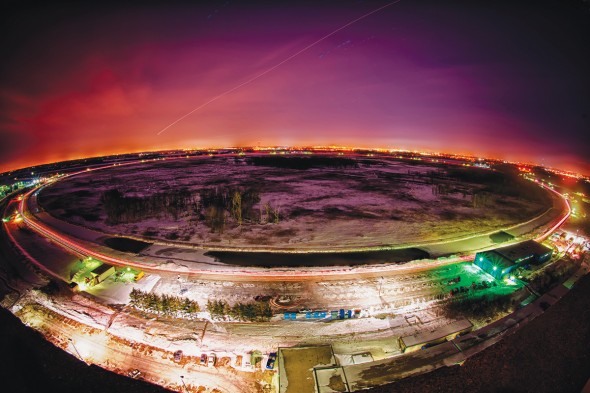Scientists find predicted way to produce puzzling particle

A night photo of Fermilab’s Tevatron collider. UIC physicists are among the scientists whose work at Fermilab led to the discovery of the final predicted way of creating a top quark.
UIC physicists are part of a collaboration of hundreds of scientists whose work led to the discovery of the final predicted way of creating a top quark — one of the most puzzling elementary particles.
UIC faculty members Mark Adams, Cecilia Gerber and Nikos Varelas are among scientists who worked on the DZero experiment at the U.S. Department of Energy’s Fermi National Accelerator Laboratory.
The top quark is the heaviest elementary particle, weighing as much as a gold atom, Varelas said.
“We have observed one of the rarest ways to produce the top quark,” said Varelas, professor of physics. “It completes a 20-year-long journey for this particle, discovered in 1995.”
In 2009 scientists, including Gerber, observed top quarks being produced individually rather than with a partner.
“It’s such a rare process that it only occurs one time out of 50 billion tries,” said Gerber, professor and associate head of physics.
“It took decades and hundreds of people to detect what is one of the rarest processes in physics.”
Scientists from the DZero and the CDF collaborations sifted through data from more than 500 trillion particle collisions produced from 2001 to 2011. They identified about 40 particle collisions that produced a single top quark through a weak nuclear force, in what is called the “s-channel.”
The particle is also important because of its interaction with the Higgs boson, which is essential to the workings of the universe. Without the Higgs, everything would be like free-floating particles of light that could not combine to create matter.
The heavier the particle, the more it interacts with the Higgs boson, Varelas said.
“Being the heaviest among all elementary particles, the top quark couples the strongest with the Higgs,” he said. “We still don’t understand what makes the top quark so special to have the mass that it has.”
When the Large Hadron Collider at CERN at the European Organization for Nuclear Research resumes operation in 2015 at higher energy, UIC scientists will continue to analyze the Higgs boson to try to understand more of its properties, Varelas said.
“Maybe the Higgs has a sibling?” he said.
